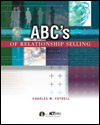The following features have been expanded or
are new to this edition: Sales Call Role-Plays. Actually used in
my classes by hundreds of students, these role-plays are created from information
used by today's top sales forces. World Wide Web. At the end of the book,
these Web exercises introduce prospective salespeople to the use of the World
Wide Web. ACT! Customer Contact. Using software for
keeping in contact with customers and prospects is a necessity in the 21st century. Student Application Learning Exercises (SALE). Chapters
directly related to creating the role-play have SALEs that aid students in better
understanding how to construct this popular class project. These were first
used in Professor Futrell's classes in the fall of 1997. Students unanimously
felt they were great in helping them correctly construct their role-plays. Selling Experiential Exercises. These end-of-chapter
exercises help students better understand themselves and/or the text material.
Many can be done within class or completed outside and discussed within class. Selling Globally. Many of these new box
items were written by friends and colleagues from countries around the world. Technology in Selling. A central theme
within each chapter shows the use of technology and automation in selling and
servicing prospects and customers. Text and Chapter Pedagogy Many reality-based features are included in
the seventh edition to stimulate learning. One major goal of this book is to
offer better ways of using it to convey sales knowledge to the reader. To do
this, the book includes numerous special features: Photo Essays. The book features many photographs
accompanied by captions that describe sales events and how they relate to chapter
materials. Chapter Topics and Objectives. Each chapter
begins with a clear statement of learning objectives and an outline of major
chapter topics. These devices provide an overview of what is to come and can
also be used by students to see whether they understand and have retained important
points. Sales Challenge/Solution. The text portion
of each chapter begins with a real-life challenge faced by sales professionals.
The challenge pertains to the topic of the chapter and will heighten students'
interest in the chapter concepts. The challenge is resolved at the end of the
chapter, where chapter concepts guiding the salesperson's actions are highlighted. Making the Sale. These boxed items explore
how salespeople, when faced with challenges, use innovative ideas to sell. Selling Tips. These boxes offer the reader
additional selling tips for use in developing their role-plays. Artwork. Many aspects of selling tend to
be confusing at first. "What should I do?" and "How should I
do it?" are two questions frequently asked by students in developing their
role-plays. To enhance students' awareness and understanding, many exhibits
have been included throughout the book. These exhibits consolidate key points,
indicate relationships, and visually illustrate selling techniques. They also
make effective use of color to enhance their imagery and appeal. Chapter Summary and Application Questions. Each
chapter closes with a summary of key points to be retained. The application
questions are a complementary learning tool that enables students to check their
understanding of key issues, to think beyond basic concepts, and to determine
areas that require further study. The summary and application questions help
students discriminate between main and supporting points and provide mechanisms
for self-teaching. Key Terms for Selling/Glossary. Learning
the selling vocabulary is essential to understanding today's sales world. This
is facilitated in three ways. First, key concepts are boldfaced and completely
defined where they first appear in the text. Second, each key term, followed
by the page number where it was first introduced and defined, is listed at the
end of each chapter. Third, a glossary summarizing all key terms and definitions
appears at the end of the book for handy reference. Ethical Dilemma. These challenging exercises
give students an opportunity to experience ethical dilemmas faced in the selling
job. Students should review Chapter 2's definition and explanation of ethical
behavior before discussing the ethical dilemmas. Further Exploring the Sales World. These
projects ask students to go beyond the textbook and classroom to explore what's
happening in the real world. Projects can be altered or adapted to the instructor's
school location and the learning objectives for the class. Cases for Analysis. Each chapter ends with
several brief but substantive cases for student analysis and class discussion.
These cases provide an opportunity to students to apply concepts to real events
and to sharpen their diagnostic skills for sales problem solving. As you see, the publisher and I have thoroughly
considered how best to present the material to readers to maximize their interest
and learning. Teacher, reviewer, and student response to this revision has been
fantastic. They are pleased with the readability, reasonable length, depth,
and breadth of the material. You will like this edition better than the last
one. | 



 2002 McGraw-Hill Higher Education
2002 McGraw-Hill Higher Education


 2002 McGraw-Hill Higher Education
2002 McGraw-Hill Higher Education